Why Do Chainsaws Leak Bar Oil? Understanding the Causes and Solutions
- January 29, 2024
- 2 comment
Owning a chainsaw means dealing with the frustration of oil leaks, which can be both messy and perplexing, especially if your chainsaw is relatively new or well-maintained. This article delves into the common causes of these leaks, the importance of lubrication, and how to manage and potentially prevent these leaks from occurring.
Understanding Chainsaw Lubrication
Lubrication is crucial for the longevity and proper functioning of your chainsaw. The chain and bar, in particular, require consistent lubrication to avoid excessive heat and subsequent damage. Chainsaws come equipped with an oil tank specifically designed to store this vital oil, gradually releasing it to the guide bar through an oil pump. However, if this system isn’t functioning properly or is interrupted, it can lead to leaks and inadequate lubrication.
Common Causes of Chainsaw Oil Leaks
Chainsaw owners often encounter oil leaks, even in newly purchased models. Upon placing the chainsaw on a surface, a common complaint is the discovery of a pool of oil underneath it. This leakage can be attributed to various factors:
- Leaks can stem from a compromised oil tank, a cap that doesn’t seal correctly, or a malfunctioning vent in the oil tank, which should only allow air in and prevent oil from escaping.
- A primary reason for perceived leaks isn’t an actual leak but rather residual oil. After use, bar and chain oil that’s splattered inside or trapped in the bar groove tends to drip out slowly, especially when the chainsaw is stored, creating a misleading puddle beneath it.
- Chainsaws used and then stored in varying temperatures can experience leaks due to the expansion and contraction of oil in the tank. Cold oil from outdoor use, when brought into a warmer environment, expands. If the vent functions correctly, oil can sometimes be forced out through the oiler mechanism itself.
- Understanding the oil system’s workings is vital. The oil tank, equipped with a valve or breather, maintains positive pressure to ensure steady oil delivery. But, if this system is hindered, perhaps due to a vacuum created by improper ventilation, oil flow can be inconsistent, leading to leakage.
Visual Guide to Understanding Chainsaw Oil Leakage
1. Typical Oil Residue 24 Hours After Use
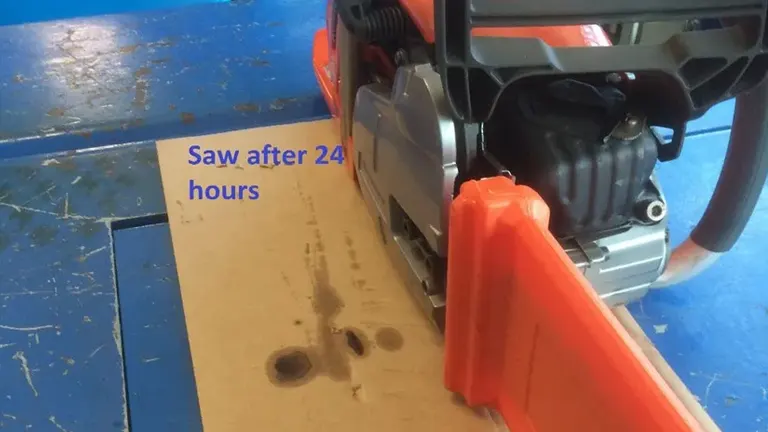
This photograph showcases a chainsaw that has been left to sit after use. Notice the sheen of oil on the body of the saw and a small puddle forming beneath it. This is typical of the residual oil dripping slowly from the bar and chain area.
2. Persistent Oil on Guide Bar 48 Hours After Last Use
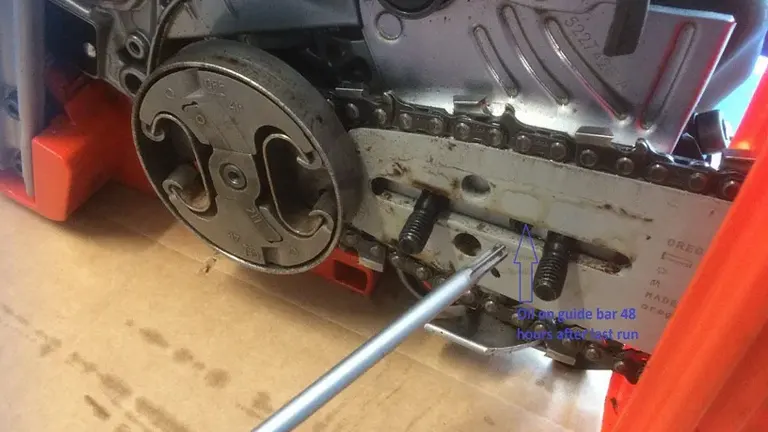
Here, you see a close-up of the guide bar. Even after 48 hours, there’s a noticeable amount of oil clinging to the bar and within the groove. This oil tends to seep out slowly, leading to the common misconception of a ‘leak’.
3. Oil Accumulation Inside the Clutch Cover
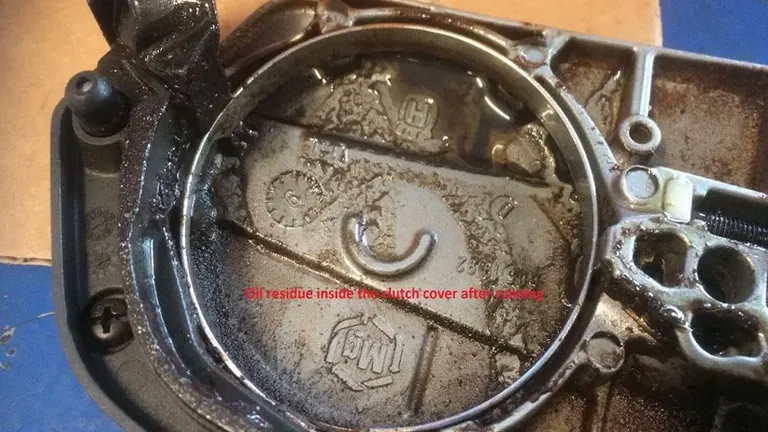
This image shows the interior of the clutch cover after just 10 minutes of operation. It’s clear how the centrifugal force of the chain’s movement flings oil into this area, where it accumulates and can contribute to the impression of leakage.
4. Common Accumulation Points Indicated by Yellow Arrows

In this detailed image, yellow arrows point to the typical ‘hot spots’ where oil tends to gather. These are structural recesses and cavities within the chainsaw’s body. Over time, oil in these spots drips down onto the surface where the chainsaw is stored, often creating those unwelcome oil spots on your garage floor.
STIHL’s One-Way Valve System
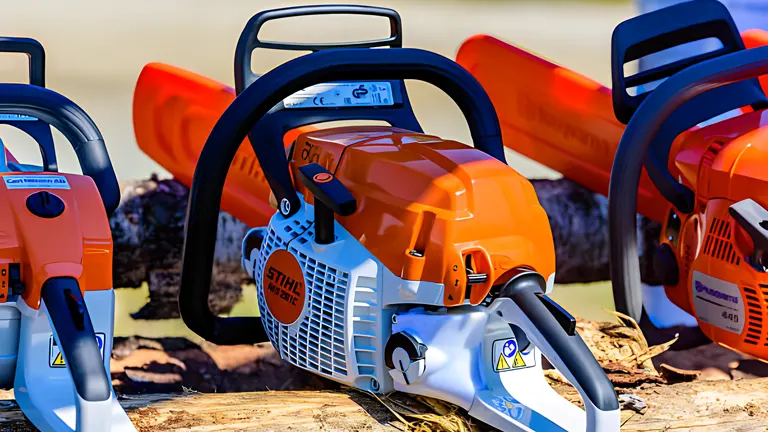
STIHL chainsaws utilize a one-way valve oil tank breathing system, allowing air into the tank during operation without causing oil leaks. However, atmospheric conditions can sometimes force oil out through the oil pump when the chainsaw is not in use, particularly in areas with significant temperature fluctuations between day and night.
Preventing and Managing Oil Leaks
- Ensure the oil system is functioning correctly by following the operator’s manual. After use, clean the chainsaw, particularly the underside and recesses, to remove residual oil.
- Avoid storing the chainsaw with full tanks of oil and fuel. Instead, top these up only before use. For long-term storage, consider draining the tanks to prevent seepage and to accommodate temperature variations.
- Properly vent your chainsaw’s oil tank to prevent vacuum formation and to manage pressure changes. For STIHL chainsaws, laying the chainsaw on its side with the oil cap upwards and slightly open can help. Remember to secure the cap before the next use.
- After cleaning, place the chainsaw on a sheet of cardboard and let it sit undisturbed. After some time, check for oil stains or pools, which can indicate whether there’s a leak that requires further investigation.
Conclusion
Chainsaw oil leaks can be a nuisance, but understanding their common causes, the importance of proper lubrication, and the methods to manage and prevent such leaks can greatly reduce the hassle and maintain your chainsaw’s performance. Regular maintenance, proper storage, and a thorough understanding of your chainsaw’s oil system are key to ensuring a long-lasting, efficient tool for your cutting needs.
Related Articles:
- Can You Use Motor Oil for Chainsaw Bar Oil: What You Need to Know
- Why Does My Chainsaw Cut Crooked? Understanding and Fixing the Issue
- How to Install Chain on Chainsaw
- How To Start A Stihl Chainsaw Step By Step: A Complete Guide
FAQs
- Can changing the type of bar oil I use reduce the likelihood of leaks?
Yes, the viscosity of the bar oil can influence leakage. Thicker oils tend to leak less, especially in warmer climates. However, always refer to your chainsaw’s manual to ensure you’re using the recommended oil type for optimal performance and safety. - Are electric chainsaws less prone to oil leaks compared to gas-powered ones?
Electric chainsaws do tend to have fewer oil leak issues because they often use a different lubrication system. However, they are not immune to leaks, especially if there are issues with the oil reservoir or if the chainsaw is stored improperly. - How does the age of a chainsaw affect its tendency to leak oil?
Older chainsaws might leak more due to wear and tear on their components, like the oil pump or the tank’s sealing system. Regular maintenance and replacing worn-out parts can help mitigate this issue. - Can the way I store my chainsaw after use affect oil leakage?
Absolutely. Storing your chainsaw horizontally with the bar and chain side facing down can lead to more leakage. Try storing it vertically or ensuring it’s on a flat surface with a mat or tray underneath to catch any residual oil. - Is it normal for a brand new chainsaw to leak oil?
While not ideal, it’s not uncommon for new chainsaws to leak a bit of oil due to residual oil in the system from testing or the oil settling in during shipping. However, consistent or excessive leaking is not normal and might warrant a check-up or a return. - How often should I check my chainsaw for potential oil leaks?
It’s good practice to check for leaks after every use, especially when the chainsaw is new or has been serviced. Regular checks can help you catch and address any leaks before they become a bigger problem. - Can the environment where I use or store my chainsaw affect oil leakage?
Yes, extreme temperatures can affect the viscosity of the oil and the pressure in the oil tank, potentially leading to leaks. Storing your chainsaw in a stable, moderate temperature can help prevent leaks caused by expansion or contraction of the oil. - If my chainsaw is leaking oil, does it always mean there’s a technical fault?
Not necessarily. As mentioned earlier, it could be residual oil dripping after use, especially if the chainsaw isn’t cleaned properly. However, if you clean your chainsaw and still notice leaks, it might be time for a technical check-up.
Join the discussion below by sharing your experiences, tips, or reviews. Your contributions help others make informed decisions and navigate their chainsaw choices with confidence. Let’s build a community of shared knowledge for all wood-cutting enthusiasts!

David Murray
Forestry AuthorI'm David Murry, a forestry equipment specialist with a focus on chainsaw operation. With over 13 years of experience, I've honed my skills in operating and maintaining a wide range of machinery, from chainsaws to log splitters. My passion for the outdoors and commitment to sustainable forestry drive my work, which emphasizes safety, efficiency, and staying updated with industry advancements. Additionally, I'm dedicated to sharing my expertise and promoting environmental awareness within the forestry community.
2 comments
Regarding powersaws leaking bar oil. I have run many powered over the last 45 years of my Forestry career. The simple solution I have used for many years is always store and transport saws on their side. Tank filler holes facing up. I hardly lose a drop.




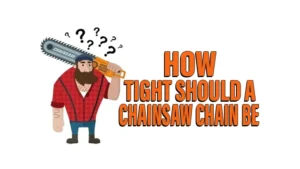







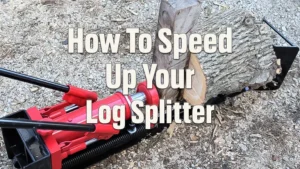
Our son bought my wife a 12" Dewalt rechargable. Overnight it leaked all the chain oil out. They had me send it in and sent me a new saw. Eventually a lady on the phone said "it's in the book." Sure enough, the book says drain the chain oil when not in use. Who does that? It was cheap. There's good reason for that.
Fritz Groszkruger
February 1, 2024 10:11 pm